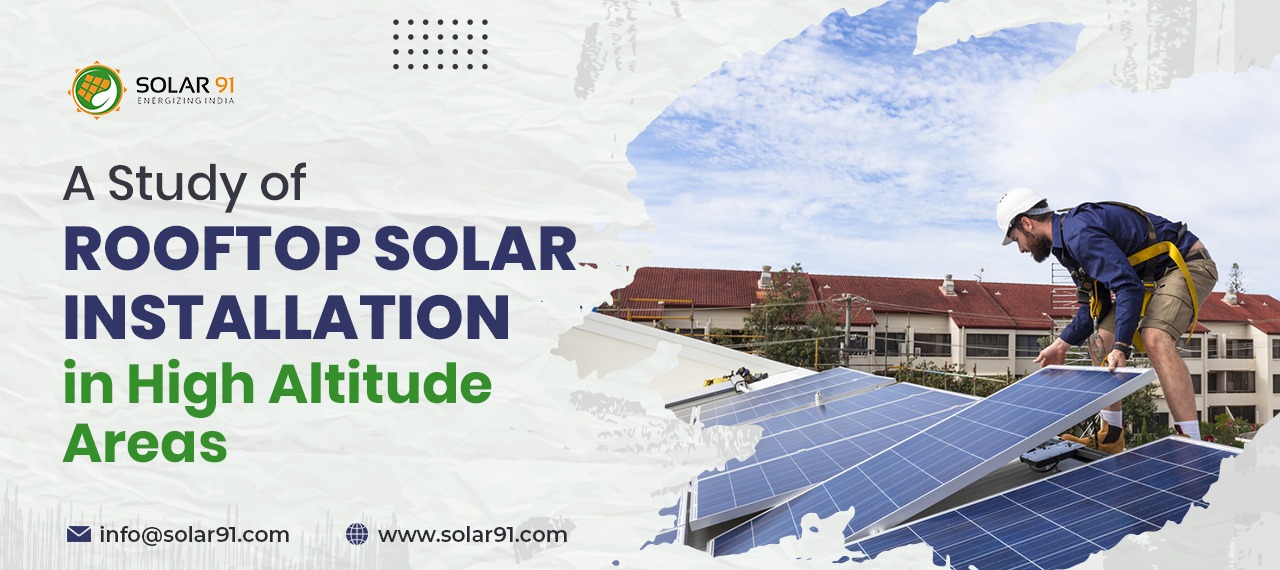A Study of Rooftop Solar Installation in High Altitude Areas
Solar panels are devices that capture and transform sunlight’s energy into electricity anytime from anywhere. Regardless of their configuration, solar panels are angled to face the sun. This is because they obtain their energy from sunlight prior to conversion. As a result, whether on the roof or the ground, the panels must be angled in a way that is more exposed to the sun’s rays. So there is little doubt that solar panels perform better at higher elevations.
Furthermore, they are more exposed to solar energy than at sea level. As a result, they can better convert energy into electricity for our daily needs. Thus, solar panels positioned at a given altitude above the ground can boost efficiency and power output, which can be defined as the most straightforward approach to using the fewest resources necessary to get the largest possible output.
Without further ado, let’s delve into all you need to know about solar panel efficiency in energy production at high elevations.
Solar Panels & Solar Radiations
Solar radiation, often known as sunshine, is the electromagnetic radiation emitted by the sun. Solar radiation can be captured and turned into useful forms of energy such as heat and electricity using a variety of technologies. The amount of solar energy available determines the technical viability and cost-effectiveness of various technologies in a specific region. The Photovoltaic (PV) system, which uses solar panels to directly convert sunlight into power, is the most useful solar energy production technology.
The Earth receives 174 petawatts (PW) of incoming solar radiation in its upper atmosphere. 70% of this sunlight is absorbed by clouds, oceans, and landmasses, and the remaining 30% is reflected in space. We use 70% of the energy that comes from the sun and utilize the workings of our panels to suit our energy needs.
Effect of Altitude on Solar Radiations
The amount of air molecules, ozone, aerosols, and clouds above the relevant surface in the atmosphere decreases with height, while solar UV radiation increases with altitude. Recent studies show that gathering solar power at high altitudes is more efficient than at sea level. This supports the notion that at high altitudes, we receive more direct irradiation and less dispersed radiation. As a result, the availability of complete solar radiation at higher elevations allows for the creation of a more efficient PV system than ground-mounted PV systems.
Does Solar Power Work Better At High Altitudes?
Solar panel systems are one of the most efficient sources of clean energy, although they are often built at sea level. However, one can wonder if solar power works better at higher altitudes. The basic idea would suggest that it should because it is closer to the sun, but this is not it. Sunlight creates electromagnetic radiation, also known as solar radiation, which the PV cells in solar panels absorb to generate electricity. However, this energy is occasionally hindered by various elements such as dust, dirt, or snow, preventing our solar panels from performing to their full potential.
However, at high elevations, there is less of an air barrier, which may prevent them from properly utilizing the sunlight. As a result of less impediment, these solar panels perform better at high altitudes. Increasing solar radiation exposure usually results in a rise in generated voltage output, which ultimately contributes to improved efficiency. This is conceivable because humans get more direct irradiation and less dispersed radiation at higher altitudes.
Solar Panel Efficiency at High Altitude Areas
Even at high altitudes, solar panels do not perform consistently in all environments, and several factors can affect their production efficiency. Such conditions include:
Shade
Shade, a sort of sun-blocking, is a significant hindrance to solar panels from receiving sunlight. Although cloudy skies are not always synonymous with shade, such days result in less productive electricity production from the panels because they do not cover them from sunlight.
So, if you wish to install a solar panel system, first, be sure that nothing in the vicinity is shading your PV cells. Trees, satellite dishes, towering buildings, and other structures, for example, should not obstruct your solar panels. It should also be noted that solar panels can still absorb some solar energy if put in a shaded area. However, it would not be able to absorb all of the sunlight.
Under cloudy conditions, panels continue to receive and convert sunlight, but at a slower rate. Installing solar panels at higher altitudes reduces shading, resulting in more output power.
Weather
Several weather conditions have varying but significant effects on the effectiveness of your solar panels. Let’s start with a bright sunny day. Contrary to popular belief, excessive heat can significantly limit the efficacy of solar panels.
Solar power performance is determined by the amount of sunlight absorbed by the panels, not by the temperature surrounding them. As a result, excessive sunlight can induce high heat and overheating.
Snow panels retain enough heat to melt the snow that has collected on top of them, whereas hail can shatter the glass of solar panels. Solar panels installed at higher altitudes will counteract weather conditions, resulting in enhanced efficiency.
Upkeep
Solar panels are not immune to common obstructions like dust and debris. These blockages restrict sunlight from reaching the solar cells, resulting in reduced exposure to sunshine and lower efficiency. Solar panels installed at higher altitudes will receive more sunshine, resulting in increased efficiency. The installation of solar panels at higher elevations reduces the effects of the accumulation of dirt on the panels and increases efficiency.
Conclusion
Solar panels at a greater height will receive more solar radiation than those at ground level, resulting in more power output. Because good solar energy is available at a higher altitude, a more efficient PV system can be built than ground-mounted PV systems. It can be identified as the most straightforward approach for achieving the highest feasible output with the fewest resources possible.

